Yikang Ding
Kling-Avatar: Grounding Multimodal Instructions for Cascaded Long-Duration Avatar Animation Synthesis
Sep 11, 2025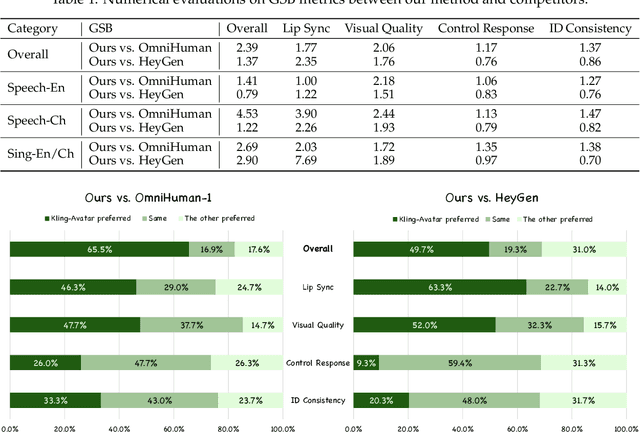

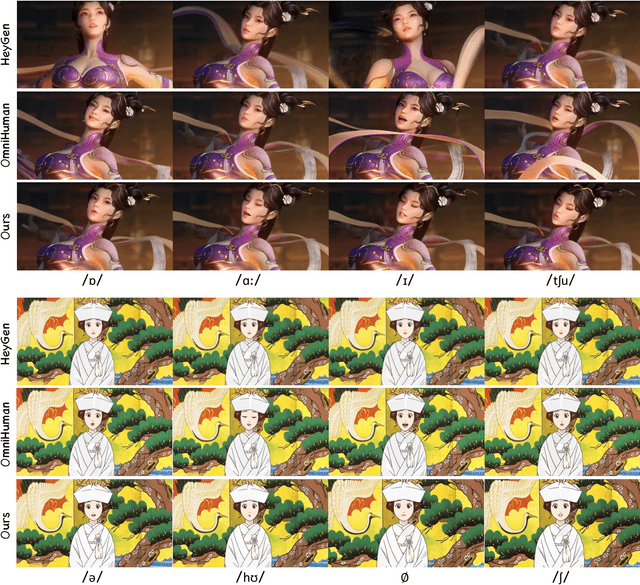
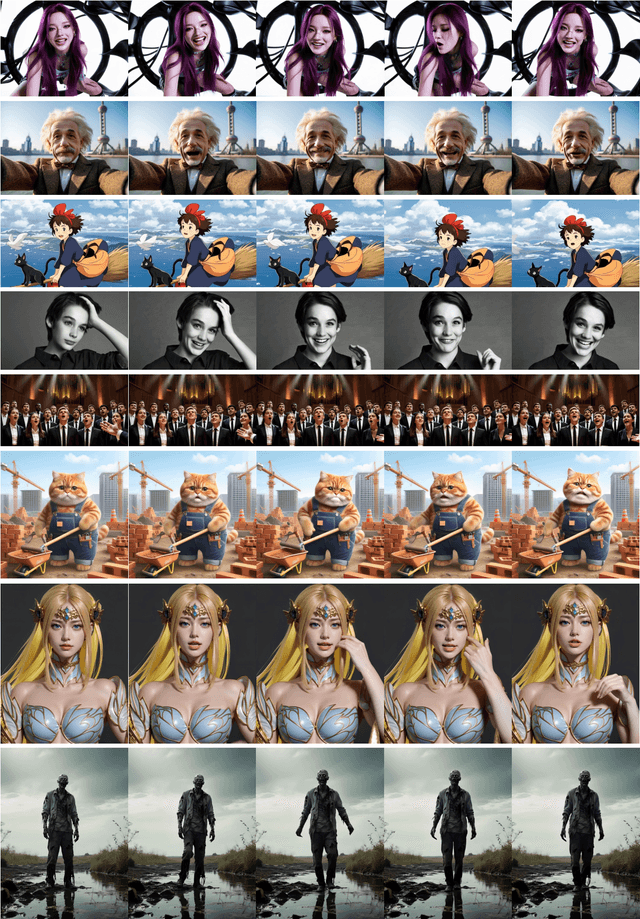
Abstract:Recent advances in audio-driven avatar video generation have significantly enhanced audio-visual realism. However, existing methods treat instruction conditioning merely as low-level tracking driven by acoustic or visual cues, without modeling the communicative purpose conveyed by the instructions. This limitation compromises their narrative coherence and character expressiveness. To bridge this gap, we introduce Kling-Avatar, a novel cascaded framework that unifies multimodal instruction understanding with photorealistic portrait generation. Our approach adopts a two-stage pipeline. In the first stage, we design a multimodal large language model (MLLM) director that produces a blueprint video conditioned on diverse instruction signals, thereby governing high-level semantics such as character motion and emotions. In the second stage, guided by blueprint keyframes, we generate multiple sub-clips in parallel using a first-last frame strategy. This global-to-local framework preserves fine-grained details while faithfully encoding the high-level intent behind multimodal instructions. Our parallel architecture also enables fast and stable generation of long-duration videos, making it suitable for real-world applications such as digital human livestreaming and vlogging. To comprehensively evaluate our method, we construct a benchmark of 375 curated samples covering diverse instructions and challenging scenarios. Extensive experiments demonstrate that Kling-Avatar is capable of generating vivid, fluent, long-duration videos at up to 1080p and 48 fps, achieving superior performance in lip synchronization accuracy, emotion and dynamic expressiveness, instruction controllability, identity preservation, and cross-domain generalization. These results establish Kling-Avatar as a new benchmark for semantically grounded, high-fidelity audio-driven avatar synthesis.
Less is Enough: Training-Free Video Diffusion Acceleration via Runtime-Adaptive Caching
Jul 03, 2025Abstract:Video generation models have demonstrated remarkable performance, yet their broader adoption remains constrained by slow inference speeds and substantial computational costs, primarily due to the iterative nature of the denoising process. Addressing this bottleneck is essential for democratizing advanced video synthesis technologies and enabling their integration into real-world applications. This work proposes EasyCache, a training-free acceleration framework for video diffusion models. EasyCache introduces a lightweight, runtime-adaptive caching mechanism that dynamically reuses previously computed transformation vectors, avoiding redundant computations during inference. Unlike prior approaches, EasyCache requires no offline profiling, pre-computation, or extensive parameter tuning. We conduct comprehensive studies on various large-scale video generation models, including OpenSora, Wan2.1, and HunyuanVideo. Our method achieves leading acceleration performance, reducing inference time by up to 2.1-3.3$\times$ compared to the original baselines while maintaining high visual fidelity with a significant up to 36% PSNR improvement compared to the previous SOTA method. This improvement makes our EasyCache a efficient and highly accessible solution for high-quality video generation in both research and practical applications. The code is available at https://github.com/H-EmbodVis/EasyCache.
DiST-4D: Disentangled Spatiotemporal Diffusion with Metric Depth for 4D Driving Scene Generation
Mar 19, 2025



Abstract:Current generative models struggle to synthesize dynamic 4D driving scenes that simultaneously support temporal extrapolation and spatial novel view synthesis (NVS) without per-scene optimization. A key challenge lies in finding an efficient and generalizable geometric representation that seamlessly connects temporal and spatial synthesis. To address this, we propose DiST-4D, the first disentangled spatiotemporal diffusion framework for 4D driving scene generation, which leverages metric depth as the core geometric representation. DiST-4D decomposes the problem into two diffusion processes: DiST-T, which predicts future metric depth and multi-view RGB sequences directly from past observations, and DiST-S, which enables spatial NVS by training only on existing viewpoints while enforcing cycle consistency. This cycle consistency mechanism introduces a forward-backward rendering constraint, reducing the generalization gap between observed and unseen viewpoints. Metric depth is essential for both accurate reliable forecasting and accurate spatial NVS, as it provides a view-consistent geometric representation that generalizes well to unseen perspectives. Experiments demonstrate that DiST-4D achieves state-of-the-art performance in both temporal prediction and NVS tasks, while also delivering competitive performance in planning-related evaluations.
MuDG: Taming Multi-modal Diffusion with Gaussian Splatting for Urban Scene Reconstruction
Mar 13, 2025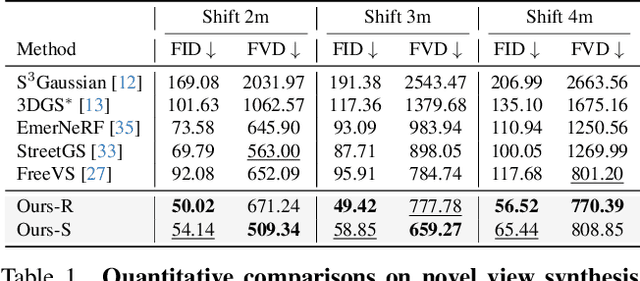
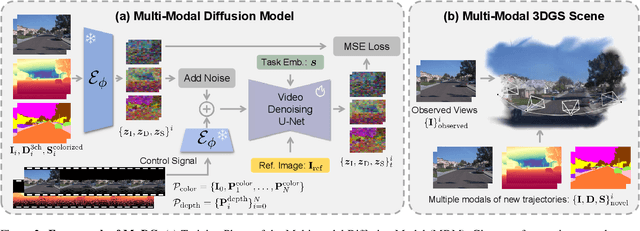

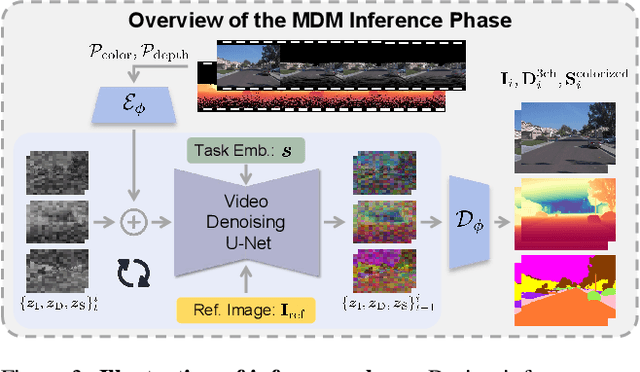
Abstract:Recent breakthroughs in radiance fields have significantly advanced 3D scene reconstruction and novel view synthesis (NVS) in autonomous driving. Nevertheless, critical limitations persist: reconstruction-based methods exhibit substantial performance deterioration under significant viewpoint deviations from training trajectories, while generation-based techniques struggle with temporal coherence and precise scene controllability. To overcome these challenges, we present MuDG, an innovative framework that integrates Multi-modal Diffusion model with Gaussian Splatting (GS) for Urban Scene Reconstruction. MuDG leverages aggregated LiDAR point clouds with RGB and geometric priors to condition a multi-modal video diffusion model, synthesizing photorealistic RGB, depth, and semantic outputs for novel viewpoints. This synthesis pipeline enables feed-forward NVS without computationally intensive per-scene optimization, providing comprehensive supervision signals to refine 3DGS representations for rendering robustness enhancement under extreme viewpoint changes. Experiments on the Open Waymo Dataset demonstrate that MuDG outperforms existing methods in both reconstruction and synthesis quality.
HERMES: A Unified Self-Driving World Model for Simultaneous 3D Scene Understanding and Generation
Jan 24, 2025



Abstract:Driving World Models (DWMs) have become essential for autonomous driving by enabling future scene prediction. However, existing DWMs are limited to scene generation and fail to incorporate scene understanding, which involves interpreting and reasoning about the driving environment. In this paper, we present a unified Driving World Model named HERMES. We seamlessly integrate 3D scene understanding and future scene evolution (generation) through a unified framework in driving scenarios. Specifically, HERMES leverages a Bird's-Eye View (BEV) representation to consolidate multi-view spatial information while preserving geometric relationships and interactions. We also introduce world queries, which incorporate world knowledge into BEV features via causal attention in the Large Language Model (LLM), enabling contextual enrichment for understanding and generation tasks. We conduct comprehensive studies on nuScenes and OmniDrive-nuScenes datasets to validate the effectiveness of our method. HERMES achieves state-of-the-art performance, reducing generation error by 32.4% and improving understanding metrics such as CIDEr by 8.0%. The model and code will be publicly released at https://github.com/LMD0311/HERMES.
UniScene: Unified Occupancy-centric Driving Scene Generation
Dec 06, 2024Abstract:Generating high-fidelity, controllable, and annotated training data is critical for autonomous driving. Existing methods typically generate a single data form directly from a coarse scene layout, which not only fails to output rich data forms required for diverse downstream tasks but also struggles to model the direct layout-to-data distribution. In this paper, we introduce UniScene, the first unified framework for generating three key data forms - semantic occupancy, video, and LiDAR - in driving scenes. UniScene employs a progressive generation process that decomposes the complex task of scene generation into two hierarchical steps: (a) first generating semantic occupancy from a customized scene layout as a meta scene representation rich in both semantic and geometric information, and then (b) conditioned on occupancy, generating video and LiDAR data, respectively, with two novel transfer strategies of Gaussian-based Joint Rendering and Prior-guided Sparse Modeling. This occupancy-centric approach reduces the generation burden, especially for intricate scenes, while providing detailed intermediate representations for the subsequent generation stages. Extensive experiments demonstrate that UniScene outperforms previous SOTAs in the occupancy, video, and LiDAR generation, which also indeed benefits downstream driving tasks.
M${^2}$Depth: Self-supervised Two-Frame Multi-camera Metric Depth Estimation
May 03, 2024
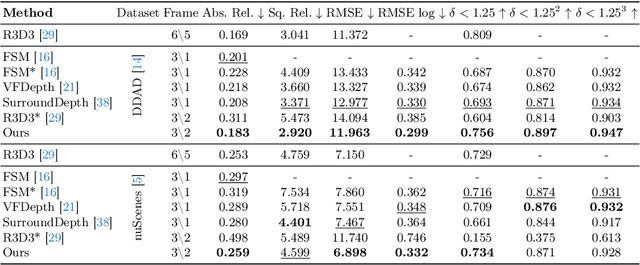
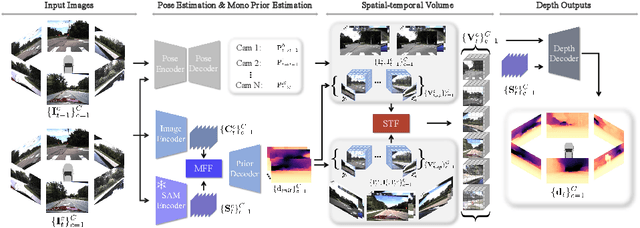

Abstract:This paper presents a novel self-supervised two-frame multi-camera metric depth estimation network, termed M${^2}$Depth, which is designed to predict reliable scale-aware surrounding depth in autonomous driving. Unlike the previous works that use multi-view images from a single time-step or multiple time-step images from a single camera, M${^2}$Depth takes temporally adjacent two-frame images from multiple cameras as inputs and produces high-quality surrounding depth. We first construct cost volumes in spatial and temporal domains individually and propose a spatial-temporal fusion module that integrates the spatial-temporal information to yield a strong volume presentation. We additionally combine the neural prior from SAM features with internal features to reduce the ambiguity between foreground and background and strengthen the depth edges. Extensive experimental results on nuScenes and DDAD benchmarks show M${^2}$Depth achieves state-of-the-art performance. More results can be found in https://heiheishuang.xyz/M2Depth .
The Devil is in the Edges: Monocular Depth Estimation with Edge-aware Consistency Fusion
Mar 30, 2024Abstract:This paper presents a novel monocular depth estimation method, named ECFNet, for estimating high-quality monocular depth with clear edges and valid overall structure from a single RGB image. We make a thorough inquiry about the key factor that affects the edge depth estimation of the MDE networks, and come to a ratiocination that the edge information itself plays a critical role in predicting depth details. Driven by this analysis, we propose to explicitly employ the image edges as input for ECFNet and fuse the initial depths from different sources to produce the final depth. Specifically, ECFNet first uses a hybrid edge detection strategy to get the edge map and edge-highlighted image from the input image, and then leverages a pre-trained MDE network to infer the initial depths of the aforementioned three images. After that, ECFNet utilizes a layered fusion module (LFM) to fuse the initial depth, which will be further updated by a depth consistency module (DCM) to form the final estimation. Extensive experimental results on public datasets and ablation studies indicate that our method achieves state-of-the-art performance. Project page: https://zrealli.github.io/edgedepth.
OccTransformer: Improving BEVFormer for 3D camera-only occupancy prediction
Feb 28, 2024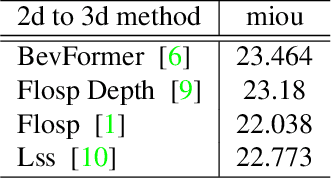

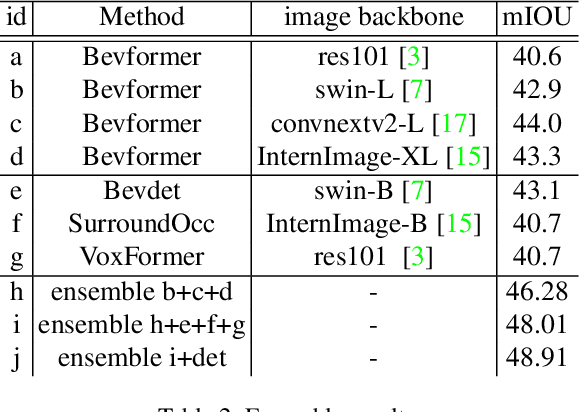
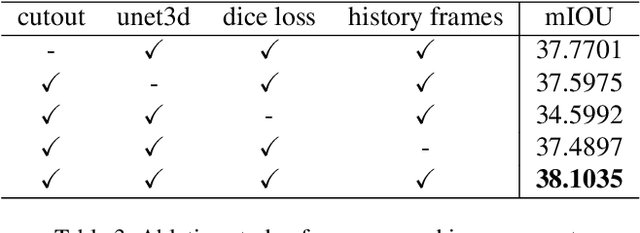
Abstract:This technical report presents our solution, "occTransformer" for the 3D occupancy prediction track in the autonomous driving challenge at CVPR 2023. Our method builds upon the strong baseline BEVFormer and improves its performance through several simple yet effective techniques. Firstly, we employed data augmentation to increase the diversity of the training data and improve the model's generalization ability. Secondly, we used a strong image backbone to extract more informative features from the input data. Thirdly, we incorporated a 3D unet head to better capture the spatial information of the scene. Fourthly, we added more loss functions to better optimize the model. Additionally, we used an ensemble approach with the occ model BevDet and SurroundOcc to further improve the performance. Most importantly, we integrated 3D detection model StreamPETR to enhance the model's ability to detect objects in the scene. Using these methods, our solution achieved 49.23 miou on the 3D occupancy prediction track in the autonomous driving challenge.
LayerDiffusion: Layered Controlled Image Editing with Diffusion Models
May 30, 2023Abstract:Text-guided image editing has recently experienced rapid development. However, simultaneously performing multiple editing actions on a single image, such as background replacement and specific subject attribute changes, while maintaining consistency between the subject and the background remains challenging. In this paper, we propose LayerDiffusion, a semantic-based layered controlled image editing method. Our method enables non-rigid editing and attribute modification of specific subjects while preserving their unique characteristics and seamlessly integrating them into new backgrounds. We leverage a large-scale text-to-image model and employ a layered controlled optimization strategy combined with layered diffusion training. During the diffusion process, an iterative guidance strategy is used to generate a final image that aligns with the textual description. Experimental results demonstrate the effectiveness of our method in generating highly coherent images that closely align with the given textual description. The edited images maintain a high similarity to the features of the input image and surpass the performance of current leading image editing methods. LayerDiffusion opens up new possibilities for controllable image editing.
 Add to Chrome
Add to Chrome Add to Firefox
Add to Firefox Add to Edge
Add to Edge